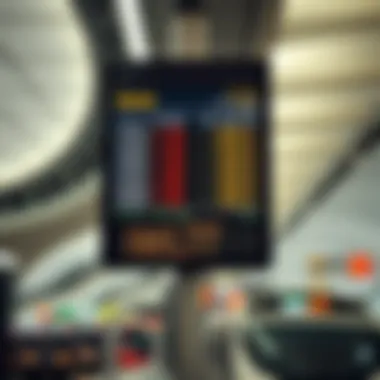Understanding Metro Dubai Time Management


Intro
In the bustling metropolis of Dubai, where modernity meets tradition, timing is everything—especially when it comes to navigating the Metro system. A well-orchestrated transit schedule can mean the difference between arriving punctual and being late. For both residents and visitors, understanding the workings of Metro Dubai Time is pivotal. From the nuances of operational hours to the implications of peak traffic, this article offers a thorough insight into the rhythmic pulse of Dubai's rail system.
Through the lens of time management, we will dissect the operational schedules, unveil peak hours, and provide practical tips to ensure smooth navigation through this essential transportation network. With Metro Dubai becoming increasingly integral to the city's infrastructure, grasping the intricacies of its timetable is more relevant than ever.
Whether you're an expatriate trying to move about the sprawling cityscape, a homeowner eager for efficient commuting options, or a visitor looking to maximize your time exploring Dubai's myriad attractions, understanding the Metro's time dynamics is crucial.
Let’s embark on this journey to decode Metro Dubai Time and how it intertwines with the larger tapestry of Dubai's transport framework.
Market Trends and Analysis
Current Market Conditions
The transport sector in Dubai is witnessing a transformative phase, marked by growing demand for public transit options. As the city burgeons with expats and tourists alike, understanding the Metro's operational hours reveals much about the broader dynamics of urban mobility.
The Metro currently operates from 5 am to midnight on weekdays, and from 5 am to 1 am on weekends. This concordance aligns with the city's rhythm, catering to both the working populace and the weekend leisure crowd. Patterns of ridership have consistently indicated peak hours early in the morning and post-work, revealing important trends in the daily flow of commuters.
Future Predictions and Growth Areas
With Dubai's vision of becoming a global leader in transport, the Metro is set to see expansions and enhancements. Expect more lines to be added and existing routes upgraded for efficiency and convenience. Analysts suggest that by 2030, we may witness an increase in Metro adoption rates by over 20%, signaling robust growth opportunities for real estate and adjacent sectors. Investing in properties near future Metro stations could yield fruitful returns, as accessibility remains a driving factor in property desirability.
"The efficiency of the public transport system directly correlates with urban property values and resident satisfaction."
Following this trajectory, understanding the rhythm of the Metro—its hours, peak operations, and expected growth—can play a pivotal role not just in navigating the transit system effectively, but also in making informed financial decisions regarding property investments in the vicinity.
By being privy to these market conditions and predictions, real estate agents, investors, and other stakeholders can strategize effectively, aligning their initiatives with the evolving demands of Dubai's vibrant population.
Overview of Metro Dubai
The Metro Dubai stands as an emblem of modern transportation in the bustling city of Dubai. This free-flowing transit system not only eases the daily commutes of thousands but also bridges the vast sections of this urban expanse. As we delve into the nuances of Metro Dubai, understanding its essence becomes paramount.
Historical Context
Metro Dubai first skidded onto the tracks in 2009, marking a significant leap in Dubai's vision to modernize its infrastructure. But let's take a step back. The project was a response to the rapid population growth and the increasing traffic congestion seen in the earlier years of the millennium. The establishment aimed to offer a sustainable and efficient alternative to traditional transport methods. Daring and ambitious, the project proved that Dubai was not only a city of dreams but also a city ready to invest heavily in its future.
"The Dubai Metro is a reflection of the city’s ambition and desire to embrace innovation, ultimately knitting together the lifestyle aspirations of its residents and visitors."
Infrastructure Development
The infrastructure of Metro Dubai is a marvel to behold. Spanning over 75 kilometers with multiple lines interlacing across the city, the network is engineered with meticulous precision. Trains are manufactured under stringent safety standards, equipped with advanced technology, ensuring a smooth and reliable ride for passengers. The stations are not mere places of transit; they are vibrant hubs, featuring facilities that cater to various needs.
Key features of the infrastructure include:
- Automated Systems: Ensuring efficient operation, from ticketing to train arrivals.
- Luxury and Comfort: Each train is designed not just for speed but also for ease, featuring spacious interiors and accessibility options for everyone.
- Integrated Transport Nodes: Many stations are connected with other transportation modes like buses and taxis, showcasing a seamless travel experience.
Understanding the foundational elements of Metro Dubai is crucial for residents and visitors alike. It sheds light on the daily operations, the level of service commuters can expect, and the overall impact of such an extensive system on urban life.
The Metro functions not only as a transit solution but as a critical component of Dubai's infrastructure strategy, fueling economic growth and enhancing overall quality of life. For anyone navigating their way through this vibrant city, grasping the backdrop of the Metro Dubai is essential.
Understanding Time in Metro Dubai
Navigating through Metro Dubai's extensive system is not just about hopping on a train; understanding how time works within this framework allows riders to optimize their commuting experience. With Dubai being a global hub, managing schedules effectively is critical for both everyday commuters and occasional travelers. This section delves into time zones, operational hours, and the entire landscape surrounding Metro timing, underscoring why knowing the intricacies of this system greatly benefits users.


Time Zones and Adjustments
Metro Dubai operates under the Gulf Standard Time (GST), which is UTC +4. This means that when planning a day out or heading to work, one must consider how time zones can affect travel from one destination to another, especially if you are coming from areas like Abu Dhabi or Sharjah. Adjustments for daylight saving are not applicable here, as the region does not observe such changes. This consistency simplifies matters for the average commuter.
For example, let’s say you’re meeting a work colleague at the Dubai World Trade Centre. If you’re arriving from a neighboring emirate, you can't afford to be late due to time differences—even subtle changes can disrupt plans. With well-set schedules, the Metro can afford you a smoother journey provided you've factored in this GST structure.
Also, keep in mind that the Metro’s schedules might align with specific sectors like schools or businesses. Therefore, planning ahead is essential, especially during festive seasons when adjustments are made creatively to accommodate larger crowds.
Operating Hours of Metro Services
The exact operating hours of the Metro not only reflect its commitment to inclusivity amongst commuters but also play a crucial part in daily life. On weekdays, the Metro runs from 5 AM until midnight, while during weekends, the hours extend to 1 AM. This flexibility ensures that whether you’re an early bird or a night owl, there’s a train waiting for you.
- Weekdays: 5:00 AM - 12:00 AM
- Weekends (Friday and Saturday): 5:00 AM - 1:00 AM
As intended, these hours cater to commuters heading to work or indulging in the nightlife Dubai offers. But you should always check for updates on special occasions or public holidays since service could extend to accommodate demand.
"Knowing the Metro's timetable isn’t just beneficial; it’s essential for navigating Dubai smoothly."
In the age of technology, keeping track of these hours is easier than ever. Real-time updates through Metro's official mobile apps help users stay informed about unexpected delays or service changes. Therefore, downloading such apps can serve as your Metro bible, ensuring you have access to all the latest information.
With structured timing and clear operational hours, utilizing Metro Dubai during any time of the day becomes a predictable and enjoyable part of city life. Such comprehensiveness in the clockwork of transportation underscores Dubai’s commitment to providing an efficient travel experience.
Factors Influencing Metro Timing
Understanding the factors that influence Metro Dubai's timing is crucial for anyone who relies on this transport system, whether you're a resident, a visitor, or a stakeholder in the real estate market. The Metro serves as a backbone for Dubai's public transport, linking various neighborhoods and commercial hubs. Therefore, grasping its timing mechanisms not only enhances individual commute experiences but also affects the broader urban planning and traffic management strategies.
One of the main aspects of timing is managing the different demands placed on the Metro by passenger load, operational capabilities, and external events. Knowing when the Metro is most crowded as opposed to quieter hours gives commuters a chance to better plan their journeys. Awareness of these factors directly shapes an individual’s commuting efficiency and can significantly impact on-time arrival at workplaces, appointments, or social gatherings.
Peak vs. Off-Peak Hours
Peak hours are the bane of any commuter's existence. In Metro Dubai, peak periods typically align with the traditional workday—mornings and late afternoons. These are the times when everyone seems to be in a rush, resulting in packed trains and often longer waiting times. Knowing these hours can mean the difference between a swift trip or a frustrating battle to squeeze into an already full carriage.
In contrast, off-peak hours, usually midday and late evenings, see far more room in the carriages. During these times, trains arrive more frequently, and there’s the luxury of a bit of breathing space.
"Understanding the pulse of the Metro system is essential; timings can transform your journey from stressful to seamless."
Here’s a quick glimpse of typical peak and off-peak hours:
- Peak Hours: 7:00 AM - 9:00 AM and 5:00 PM - 8:00 PM
- Off-Peak Hours: 10:00 AM - 4:00 PM and after 8:00 PM
The difference between peak and off-peak isn’t just a matter of comfort; it also has financial implications. Fewer passengers mean more efficient operation, potentially leading to lower fares or more resources for expansions and other system improvements.
Impact of Special Events
Dubai is a city that never sleeps, filled with a flurry of activities ranging from cultural festivals to major sporting events. Such occasions induce a significant surge in passenger numbers. The Expo, for instance, attracted millions, and adjustments to Metro services were necessary to accommodate the influx.
The Metro system often introduces specific schedules for events, meaning you can expect earlier operating hours, possibly additional trains, or extended lines. Such proactive measures can greatly improve the transit experience during these bustling times.
It’s also important to note that announcements regarding changes in schedules are often made through social media channels and public display boards. Keeping an eye on Metro Dubai's official channels can help you stay ahead of the game and avoid unwanted surprises.
In summary, understanding the ebb and flow of passenger traffic, alongside the effects of special events, gives commuters an edge. Being informed allows for strategic planning, thereby enhancing one’s journey through the vibrant metropolis of Dubai.
For those looking for real-time updates or further assistance, resources like Dubai Metro's official website offer app features and customer service contacts. Travelers can also engage in community discussions around timings on platforms like Reddit or Facebook.
But above all, remember: good timing is often the secret ingredient that can turn a simple journey into an enjoyable experience.


User Guidelines for Navigating Metro Timing
Navigating the Metro Dubai system requires a keen understanding of its timing practices. This understanding is not just a matter of convenience; it can significantly enhance both the commuting experience and overall satisfaction with the service. Key elements that shape the guidelines include planning your journey and leveraging technology through mobile apps and online resources. By following these guidelines, users can significantly streamline their travel, anticipate potential delays, and ultimately save both time and energy.
Planning Your Journey
When it comes to utilizing Metro Dubai effectively, proper planning is half the battle. The Metro operates on a structured timetable that is predictable yet dynamically influenced by factors like rush hours and special events. It’s important to familiarise oneself with these peak periods. For instance, during weekdays, mornings from 7 to 9 AM can be notoriously hectic. If your itinerary allows, consider travelling outside these busy hours to enjoy a more comfortable experience.
- Research Routes: Use the Metro Dubai website or local transport forums to review different routes that might be available. Many helpful resources can show you alternate paths if one route seems too congested.
- Check Train Frequencies: During peak hours, trains run often, sometimes as frequently as every two to three minutes. However, this changes during off-peak times, where waits might stretch to ten minutes or more.
- Station Information: Familiarize yourself with the stations, including transfer points. For example, Burj Khalifa/Dubai Mall Station connects with various routes, making it easier to switch lines if needed.
It’s a good practice to account for possible delays, allowing yourself some buffer time if you have a tight schedule. Avoiding the rush and planning ahead can make a world of difference and turn your trip into a breeze.
Mobile Apps and Online Resources
In today’s fast-paced world, information at your fingertips is crucial. The Metro Dubai has invested in technology to ensure commuters have instant access to the latest updates. Here are several useful tools:
- RTA Dubai App: This app provides real-time information about train timings, route changes, and service disruptions. Receiving alerts on your device can help you make informed travel decisions.
- Journey Planner on the Dubai Metro Website: This tool allows users to input departure and arrival stations to get accurate information about the journey duration, train transfers, and next train arrivals.
- Google Maps Integration: Surprisingly, Google Maps can be a great ally when navigating Metro timings. You’ll be able to check public transport schedules, including train times, making it a handy option when planning.
Utilizing these apps not only equips you with immediate access to changing conditions but also helps in effectively managing your time. Instead of standing on a platform waiting for a train, you can arrive at the station just in time, keeping your day’s plans on track.
"In the world of public transport, those who plan ahead keep the wheels turning smoothly."
For those who navigate the bustling corridors of Metro Dubai regularly, these user guidelines serve as a roadmap to making informed decisions and enjoying a seamless transit experience.
Comparative Analysis with Other Transport Modes
In a city as dynamic as Dubai, understanding the interplay between different transportation options is critical. While the Metro Dubai is effectively designed to facilitate quick travel across the metropolis, it's essential to compare this against other modalities, especially buses and ridesharing services. This comparison can provide insights into user choices and help in making informed decisions while navigating the city.
Metro vs. Buses: Timing Considerations
When we put Metro and buses side by side, timing is often a major deciding factor. Metro services are known for their punctuality, often arriving every few minutes during peak hours. They are especially beneficial for commuters who need to get to work on time. In contrast, buses generally have longer wait times and can sometimes be affected by road traffic, making them less reliable during rush hours.
Here are a few important considerations:
- Frequency: Metro trains run more often, providing shorter intervals between services, which can be a game changer for time-sensitive commuters.
- Travel Time: While both modes offer similar distance coverage, the Metro tends to be quicker due to its designated tracks, minimizing delays caused by street congestion.
- Accessibility of Routes: Buses can reach more locations, but this can also mean longer indirect routes that are less efficient if you're trying to reach a specific destination quickly.
Moreover, during peak times, the Metro may get overcrowded while buses, despite being less frequent, may offer more flexible seating. Overall, for those prioritizing speed and reliability, Metro is usually the preferred option.
Integration with Ridesharing Services
Then there’s the fascinating world of ridesharing—an increasingly popular choice among residents and visitors alike. The synergy between Metro services and ridesharing apps like Uber and Careem ensures that commuters have access to seamless travel options. This integration can dramatically alter the timing landscape, allowing for better overall travel performance.
Here’s how ridesharing interfaces with the Metro system:
- First and Last Mile Solutions: Many users may choose to take a rideshare service to reach the nearest Metro station or the final destination after disembarking. This effectively covers the oft-forgotten stretch between home, the station, and office or leisure spots.
- Real-Time Connectivity: Both the Metro and ridesharing services are typically equipped with real-time tracking features. This means you’ll always know when the next Metro is coming and when your ride is arriving.
- Fare Savings: Integrating Metro usage with rideshare can often lead to reduced fares, especially if you plan your trip around peak vs. off-peak hours. You might find incentives or discounts available for combined travel.
In summary, both the Metro and ridesharing services in Dubai provide valuable timing advantages, but the best choice ultimately hinges on individual needs and specific travel scenarios. By understanding these options and how they interplay, commuters can optimize their journeys across one of the world’s busiest cities.
Challenges in Metro Timing Management
The realm of Metro Dubai is a bustling confluence of technology and human travel. As the city continues to expand, its metro timing management has become increasingly crucial. Efficient transportation is more than just a luxury; it's a necessity for the millions who engage with Dubai's dynamic economy and lifestyle. Yet, this well-oiled machine faces particular challenges that can disrupt operations, leading to delays and bumps along the commuter road.
Technical Delays and Communication


An undeniable aspect of public transportation involves the potential for technical glitches—these can throw a wrench into the best-laid plans. Issues like signal malfunctions, technical failures, or equipment breakdown can lead to unexpected delays. For instance, imagine a train stuck in the middle of a line because of a signal error; the ripple effect can lead to crowded platforms and unhappy passengers.
Effective communication becomes paramount during such challenges. How information is conveyed to passengers can make a world of difference. Timely announcements on service updates, delays, or diversions are essential for maintaining rider confidence. In situations where delays are imminent, having digital screens on platforms displaying real-time information can be the silver lining. Additionally, many riders benefit from using mobile apps that sync with Metro services to receive notifications about delays.
- Real-time notifications: Ensures riders are informed as soon as possible about changes.
- Crowd management: Helps in directing flow at stations during peak times or after delays.
- Feedback systems: User reports can identify patterns in delays, enabling better future planning.
"In transport, being informed is half the battle; knowing what’s happening ahead can save time and sanity."
Passenger Volume vs. Capacity Management
With the growth of Dubai, the passenger load has surged, and so has the demand for metro services. On any given morning, the metro is akin to a beehive during peak hours, buzzing with commuters. Balancing this passenger volume with the metro's capacity is a fine art that challenges operators on a daily basis.
Capacity management techniques must be constantly refined to accommodate an increasing number of riders effectively. This includes scheduling additional trains during peak hours, optimizing train frequency, and ensuring that stations can handle the inflow of passengers without becoming overcrowded.
Moreover, understanding commuter behavior helps in predicting passenger patterns. For example, if Fridays tend to see a spike in leisure travelers, the metro can prepare to adjust schedules accordingly on those days.
- Scheduled downtime: Scheduled maintenance can lead to temporary service changes, making off-peak hours an essential time for essential repairs.
- Expanding stations: Increasing the size and facilities of major stations is a long-term plan that can smoothen the overall flow.
Ultimately, addressing the challenges of metro timing management involves a continuous loop of feedback and adjustment, ensuring the system evolves in tandem with the city. Navigating the present issues will highlight areas for growth, making the Dubai Metro not just a transit option, but an integral part of the city’s future.
Future Developments in Metro Timing
As Metro Dubai continues to evolve to meet the demands of a growing population and increasing tourism, the future of metro timing is an area ripe for innovation and advancement. Understanding these forthcoming developments is crucial for commuters, investors, and all stakeholders in the real estate and transportation sectors. The overarching goal of these advancements is to provide a streamlined, efficient, and user-friendly experience for all passengers.
Technological Innovations
The integration of cutting-edge technology stands at the forefront of the future developments concerning Metro Dubai’s timing. Innovations such as real-time tracking applications and AI-driven analytics can greatly enhance user experience by mitigating delays and improving accuracy in scheduling. For instance, an app that provides live updates on train positions allows passengers to plan their journeys with greater precision and flexibly adjust their travel plans based on current conditions.
Moreover, employing machine learning algorithms can help predict peak hours more accurately by analyzing historical data, which means better load management during busier periods. This proactive approach not only enhances reliability but can also lead to improved ticketing systems and faster boarding processes. As technology advances, we can expect to see an increase in smart ticketing solutions that might incorporate biometric scans or mobile wallet features, reducing wait times and simplifying ticketing altogether.
"Investments in technology not only improve the passenger experience but also maximize operational efficiency across the Metro Dubai system."
Expansions and New Routes
With an eye toward the future, the expansion of Metro lines and the introduction of new routes are pivotal for enhancing the connectivity of Dubai. Expansions can alleviate congestion and offer greater access to key urban areas, which is particularly beneficial for real estate development. New routes are in the pipeline that seek to connect underserved neighborhoods and integrate seamlessly with other transportation modes, like buses and trams.
For example, proposed routes could connect regions such as Dubai South, which is developing rapidly with commercial and residential projects. This would not only shorten travel times for residents but also likely boost property values in nearby areas. Furthermore, with the upcoming World Expo, additional routes may be constructed to accommodate an influx of public demand during that significant event.
Through focused expansions, Metro Dubai can remain a cornerstone of the city’s infrastructure, effectively addressing both current and projected population dynamics. Plans for extended service hours during special occasions can also be anticipated, ensuring a robust response to the needs of commuters during major events.
In summary, as Dubai forges ahead, the focus on technological advancements and strategic expansions will be crucial in shaping the future of Metro timing. These developments are not merely enhancements; they are necessary adaptations to create a responsive and efficient public transportation system that benefits all stakeholders in this vibrant metropolis.
Epilogue
As we draw our exploration of Metro Dubai time to a close, it becomes clear that understanding how time management operates within this intricate transit system holds significant importance for residents, businesses, and tourists alike. The article has unpacked various elements, leading to critical insights toward optimizing the commuting experience.
Summation of Key Insights
Here are the key takeaways:
- Operational Hours: Metro Dubai follows a structured schedule that ensures regularity, crucial for planning commutes effectively. Most lines run from 5 AM to midnight on weekdays, allowing adequate flexibility in travel.
- Peak Hours: Knowing peak versus off-peak times can save considerable time. During rush hours, trains can fill up quickly, impacting the availability of space and travel efficiency.
- Event Influence: Major events, whether local festivals or international exhibitions, significantly impact ridership, often resulting in alterations to normal schedules. Awareness of such occurrences can aid in avoiding unexpected delays.
- Tech Integration: The use of mobile apps for live updates helps facilitate real-time decision-making, making the journey less stressful and more predictable.
"The savvy commuter is one who not only rides the Metro but also understands its rhythms and flows."
By synthesizing all of the above, it’s evident that utilizing Metro Dubai's time efficiently is more than just a convenience; it’s a necessary aspect of navigating a bustling urban landscape.
Implications for Commuters
Understanding Metro timing can be a game changer for travelers of all sorts. Whether one is a real estate agent showing properties or an expatriate navigating the city anew, knowledge in this area fosters better planning. Here are some implications for commuters:
- Enhanced Time Management: Knowing the schedule can help in organizing personal and professional obligations, allowing for more productive days.
- Financial Considerations: For investors and business owners, understanding peak times can influence decisions on property location or staffing needs based on transport accessibility.
- Social Integration: For newcomers, mastering the Metro’s timing fosters a sense of belonging and enhances connectivity within Dubai's diverse community.











